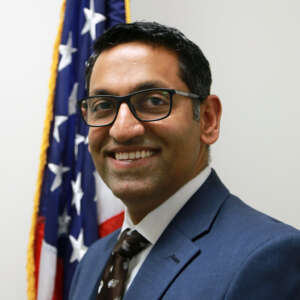

DHS has a new chief information security officer, while the State Department has a new chief data officer and HHS names the first chief artificial intelligence...
Seven agencies will be looking for new chief information officers next week.
The departments of Homeland Security, Defense, Housing and Urban Development, State, Transportation and Veterans Affairs, as well as the Social Security Administration, will be saying good-bye to their politically-appointed CIOs. So too, will the Office of Management and Budget where Basil Parker, the federal CIO, and Camilo Sandoval, the federal chief information security officer, also will be exiting after a short tenure.
Rajive Mathur, the SSA CIO, left in October, but the last day for the others is expected to be Friday, according to government sources familiar with the expected changeover.
Stuart McGuigan, the State Department’s chief information officer, told staff on Monday that he is leaving on Jan. 20.

State confirmed McGuigan is leaving.
“Mr. McGuigan leaves behind a legacy of leading the department’s worldwide information technology transformation during the COVID-19 crisis, enterprise architecture, cybersecurity management, IT service delivery and talent management, to name just a few,” said a State spokesperson in an email to Federal News Network.
He has been CIO since March 2019 after Secretary Mike Pompeo appointed him to the position. Before coming to State, McGuigan spent his career in the private sector with companies such as Johnson & Johnson, where he was vice president and CIO, and CVS Caremark.
McGuigan is one of the few State CIOs who hadn’t previously worked at the agency either in the technology office or as a Foreign Service officer.
During his time at State, McGuigan led several initiatives including the reorganization of how the agency oversees cybersecurity, moving toward an agile approach to software development and adding more rigor to the IT review process.
State has a $2.6 billion IT budget in fiscal 2021, up from $2.4 billion last year. The Federal IT Dashboard states 81% of State’s projects are on schedule, but only 56% are on budget.
The other CIOs who are leaving by Jan. 20 include:
David Chow, HUD: Joined in August 2018, making him one of the longest serving political CIOs. Chow led HUD’s partnership with the IT Modernization Centers of Excellence and took advantage of the Technology Modernization Fund (TMF) loan to address long-standing legacy challenges.

Ryan Cote, Transportation: Joined in March 2019 and picked up the “big hairy audacious goals (BHAG)” of IT modernization that his predecessor, Vicki Hildebrand, launched. Cote said he focused on consolidating networks and improving the overall architecture, and consolidating about 1,700 web applications into a single platform.
Dana Deasy, DoD: Joined in April 2018, Deasy inherited the JEDI cloud program that remains mired in delays and protests. Despite his inability to get JEDI moving, he found success in creating several new strategies for digital transformation, identity and access management, and for data management. Most importantly, maybe, Deasy ensured the military services and defense agencies could telework during the pandemic, developing and launching the Commercial Virtual Remote (CVR) to support 250,000 remote workers a day.
Karen Evans, DHS: Became CIO in May, focusing on network modernization and security center operations upgrades. Evans also helped DHS thrive during the pandemic by expanding the virtual private network and implementing collaboration tools.
Jim Gfrerer, VA: Joined VA in January 2019, focusing on IT modernization, especially during the pandemic where he upgraded network capacity and addressed the challenges with the Trusted Internet Connections (TIC) requirements.
The CIOs aren’t the only federal executives on the move.
Ken Bible is the new chief information security officer at DHS, coming over after spending the last five-plus years as the deputy CIO for the Marines Corps. He replaces Paul Beckman, who left in January 2020.
Also over at DHS, Daniel Kroese, the acting deputy assistant director of the National Risk Management center at the Cybersecurity and Infrastructure Security Agency, left to become the new staff director for the Republicans on the House Homeland Security Committee.
Kroese came to CISA in 2018 to help launch the center from Rep. John Ratcliff’s office where he was chief of staff.
“[I] couldn’t be more excited to start this week as staff director on the House Committee on Homeland Security for Ranking Member John Katko (R-N.Y.). From cybersecurity to border security to counterterrorism and emergency preparedness – these are incredibly important issue areas where the country demands professionalism,” he wrote on LinkedIn. “Thank you to the dedicated men and women of the Cybersecurity and Infrastructure Security Agency for your friendship and partnership these past three years. It was an honor to work for great leaders like Christopher Krebs and Bob Kolasky. The fight continues, and I’ll see you on the other side.”
Oki Mek is inaugurating a new CXO position over at the Department of Health and Human Services. Mek, who has been with HHS for 10 years, is the new chief artificial intelligence officer (CAIO). Previously, he was the senior advisor to the CIO working on Reimagine HHS and the chief technology officer in the acquisition office.
While State is losing its CIO, it has gained a chief data officer. State named Matthew Graviss as its first permanent CDO. He previously served as the CDO at the U.S. Citizenship and Immigration Service in the Department of Homeland Security.

NOAA also lost a key technology executive. Roy Varghese, the NOAA Fisheries CIO, took a new job with the Administrative Office of the U.S. Courts as the chief of the case management system office. He had been the NOAA Fisheries CIO since 2017 and with the agency since 2009.
“This job has been the best job of my life. That’s because the people I worked with became my close friends, the work I was doing was challenging and creative, and I am passionate about the environmental stewardship mission of NOAA. However, the most important reason why I loved NOAA was because my colleagues made me feel like I belonged there throughout my career,” Varghese wrote in a post on LinkedIn.
Earl Warrington, who spent more than 30 years in government, retired from the Small Business Administration where he was an IT program manager since July 2019. Warrington also worked at GSA for 18 years.
“New Year’s Eve, I concluded my 30+ year career with federal government. I want to thank the thousands of customers, industry partners and fellow government teammates and strategic partners for your support and trust over these many years,” Warrington wrote on LinkedIn. “It has been an honor and a privilege to serve and help to make a difference in the public sector on many presidential initiatives and agency mission objectives. These technologies and solutions have made such a positive impact on people’s lives. I have been blessed to work for incredible leaders; be a part of successful teams; and most of all to lead so many dedicated, smart and passionate people committed to excellence. Thanks for the ride and the drive. I’ll always be proud to have been a civil servant :-) Looking forward to my next adventure helping the private sector with their goals and mission to support government.”
Warrington said he will continue working as the director and co-founder of Government Sales and Consulting LLC.
On a sad note, John Garing, the former director of strategic planning and information at Defense Information Systems Agency, a retired Air Force colonel and an executive in the White House Communications Agency, passed away on Jan. 6. He was 78.
After leaving federal service in 2010, Garing worked at Suss Consulting and for Vion Corporation before retiring full-time in 2017.
According to the Washington Post obituary, a funeral mass will be held 10 a.m. Tuesday, Jan. 12 at St. Bridget of Ireland Catholic Church, Berryville, Virginia. Burial will be at a later date at Arlington National Cemetery. The family asks in lieu of flowers, please make a donation to Wounded Warriors Project.
Copyright © 2025 Federal News Network. All rights reserved. This website is not intended for users located within the European Economic Area.
Jason Miller is executive editor of Federal News Network and directs news coverage on the people, policy and programs of the federal government.
Follow @jmillerWFED



